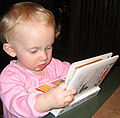Attachment theory
Attachment theory is a psychological, evolutionary and ethological theory concerning relationships between humans. The most important tenet of attachment theory is that a young child needs to develop a relationship with at least one primary caregiver for social and emotional development to occur normally. Attachment theory explains how the parent-child relationship emerges and influences subsequent development.
History[edit]
Attachment theory originated with the work of John Bowlby, a British psychiatrist and psychoanalyst who in the mid-20th century brought attention to the importance of the child-caregiver relationship for the child's emotional and social development.
Types of Attachment[edit]
There are four main types of attachment identified in children: secure attachment, anxious-resistant insecure attachment, anxious-avoidant insecure attachment, and disorganized attachment.
Secure Attachment[edit]
Children with a secure attachment see their parent as a secure base from which they can venture out and independently explore the world.
Anxious-Resistant Insecure Attachment[edit]
Children with an anxious-resistant insecure attachment tend to be anxious and are not explorative.
Anxious-Avoidant Insecure Attachment[edit]
Children with an anxious-avoidant insecure attachment tend to avoid parents or caregivers.
Disorganized Attachment[edit]
Children with a disorganized attachment often display a confusing mix of behavior and may seem disoriented, dazed, or confused.
Attachment in Adults[edit]
Adult attachment models include secure, anxious-preoccupied, dismissive-avoidant, and fearful-avoidant.
Criticisms[edit]
Attachment theory has been criticized for focusing too much on the mother-child bond and not enough on the relationships children form with other caregivers or peers.
See Also[edit]
Ad. Transform your life with W8MD's Budget GLP-1 injections from $75


W8MD offers a medical weight loss program to lose weight in Philadelphia. Our physician-supervised medical weight loss provides:
- Weight loss injections in NYC (generic and brand names):
- Zepbound / Mounjaro, Wegovy / Ozempic, Saxenda
- Most insurances accepted or discounted self-pay rates. We will obtain insurance prior authorizations if needed.
- Generic GLP1 weight loss injections from $75 for the starting dose.
- Also offer prescription weight loss medications including Phentermine, Qsymia, Diethylpropion, Contrave etc.
NYC weight loss doctor appointmentsNYC weight loss doctor appointments
Start your NYC weight loss journey today at our NYC medical weight loss and Philadelphia medical weight loss clinics.
- Call 718-946-5500 to lose weight in NYC or for medical weight loss in Philadelphia 215-676-2334.
- Tags:NYC medical weight loss, Philadelphia lose weight Zepbound NYC, Budget GLP1 weight loss injections, Wegovy Philadelphia, Wegovy NYC, Philadelphia medical weight loss, Brookly weight loss and Wegovy NYC
|
WikiMD's Wellness Encyclopedia |
| Let Food Be Thy Medicine Medicine Thy Food - Hippocrates |
Medical Disclaimer: WikiMD is not a substitute for professional medical advice. The information on WikiMD is provided as an information resource only, may be incorrect, outdated or misleading, and is not to be used or relied on for any diagnostic or treatment purposes. Please consult your health care provider before making any healthcare decisions or for guidance about a specific medical condition. WikiMD expressly disclaims responsibility, and shall have no liability, for any damages, loss, injury, or liability whatsoever suffered as a result of your reliance on the information contained in this site. By visiting this site you agree to the foregoing terms and conditions, which may from time to time be changed or supplemented by WikiMD. If you do not agree to the foregoing terms and conditions, you should not enter or use this site. See full disclaimer.
Credits:Most images are courtesy of Wikimedia commons, and templates, categories Wikipedia, licensed under CC BY SA or similar.
Translate this page: - East Asian
中文,
日本,
한국어,
South Asian
हिन्दी,
தமிழ்,
తెలుగు,
Urdu,
ಕನ್ನಡ,
Southeast Asian
Indonesian,
Vietnamese,
Thai,
မြန်မာဘာသာ,
বাংলা
European
español,
Deutsch,
français,
Greek,
português do Brasil,
polski,
română,
русский,
Nederlands,
norsk,
svenska,
suomi,
Italian
Middle Eastern & African
عربى,
Turkish,
Persian,
Hebrew,
Afrikaans,
isiZulu,
Kiswahili,
Other
Bulgarian,
Hungarian,
Czech,
Swedish,
മലയാളം,
मराठी,
ਪੰਜਾਬੀ,
ગુજરાતી,
Portuguese,
Ukrainian








